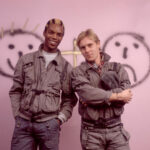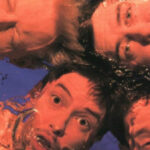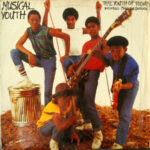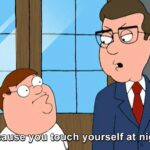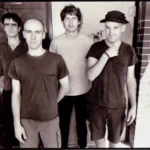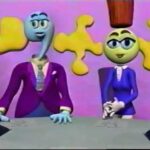 When it comes to kids’ television, there is no shortage of oddities. Shows like Teletubbies and Boohbah have baffled audiences with their surreal aesthetics, while others, like Pee-wee’s Playhouse, leaned into an offbeat charm. However, none of these prepare you for the bizarre spectacle that is Letter TV by Destoons—a fever dream of a children’s program that managed to carve out a cult following despite (or perhaps because of) its sheer weirdness.
When it comes to kids’ television, there is no shortage of oddities. Shows like Teletubbies and Boohbah have baffled audiences with their surreal aesthetics, while others, like Pee-wee’s Playhouse, leaned into an offbeat charm. However, none of these prepare you for the bizarre spectacle that is Letter TV by Destoons—a fever dream of a children’s program that managed to carve out a cult following despite (or perhaps because of) its sheer weirdness.
Premiering in 1984 and lasting a mercurial two seasons before disappearing into the annals of obscure television history, Letter TV was ostensibly an educational show designed to teach children about the alphabet, phonics, and language. But what unfolded on screen was so strange, unsettling, and disjointed that it has been the subject of fascination and debate ever since.
This article explores the history, production, and enduring legacy of Letter TV, unpacking why it remains one of the weirdest kids’ shows ever made.
The Concept: A Strange Premise from the Start
At its core, Letter TV was meant to blend education and entertainment, much like Sesame Street or The Electric Company. The premise was simple: each episode focused on a single letter of the alphabet. However, the execution was anything but straightforward.
The show took place in a fictional universe where letters were anthropomorphized and lived in a surreal city called Alphaville. The letters interacted with human hosts and other characters, each representing linguistic concepts like punctuation or grammar.
While the premise sounds innocent enough, the actual content of the show was a kaleidoscope of unsettling imagery, nonsensical dialogue, and chaotic storytelling.
The Aesthetic: A Blend of Surrealism and Nightmare Fuel
The visual style of Letter TV is one of the first things people mention when discussing its weirdness. The sets were a disorienting mix of bright colors, dim lighting, and abstract shapes. Alphaville was depicted as a labyrinthine city with no discernible logic to its design—buildings floated, streets spiraled into the sky, and doors led to nowhere.
The anthropomorphic letters themselves were uncanny. Each one was portrayed by an actor in a letter-shaped costume, but the designs were unnervingly detailed. For example:
- The letter A had a sharp, almost menacing triangular design, complete with blinking eyes inside the triangle’s apex.
- Q was depicted as a rotund figure with a spinning, hypnotic swirl in the middle of its body.
- X, perhaps the most infamous, was a skeletal figure draped in tattered fabric, leading to many young viewers describing it as “the scary letter.”
Adding to the unsettling vibe were the human hosts. The main host, Professor Punctual (played by obscure stage actor Leonard Grimsby), wore a suit covered in punctuation marks and spoke in a clipped, overly enthusiastic tone. His constant, unblinking stare into the camera gave the impression he was trying to communicate with the viewer telepathically.
The Content: Educational Chaos
While Letter TV claimed to teach literacy, its educational value was often overshadowed by its bizarre and erratic presentation. Each episode revolved around the featured letter’s adventures in Alphaville, interspersed with skits, songs, and animated segments.
1. The Skits
The live-action skits were a mix of slapstick humor and surrealism, often leaving viewers confused about their purpose. For example, in the “L” episode, there was a recurring segment where the letter L attempted to teach a lion to read but kept getting swallowed whole. The skit ended abruptly with no resolution, and the lion belched out the words “Lemonade Literature” before the scene cut away.
2. The Songs
Each episode included original songs about the featured letter. These songs, while catchy, were often nonsensical. The lyrics to “P is for Paradox,” for example, included lines like:
“Pickles on a pirate ship,
Pogo sticks and planets dip,
Parrots in pajamas flip—
Oh, P, what a trip!”
The accompanying visuals often had little to do with the lyrics, adding to the overall confusion.
3. The Animated Segments
The animated portions of Letter TV were crudely drawn and narrated by a monotone voice that many found unsettling. These segments introduced concepts like silent letters or vowel combinations but did so in a way that felt disconnected from the rest of the show. One infamous animated clip, “The Tale of G and H,” involved a silent letter “ghost” haunting the letter G until they reconciled by forming “ghoul.”
Production Mysteries and Behind-the-Scenes Oddities
The production of Letter TV was shrouded in mystery, with few records of the creative process or the people behind it. The show was produced by Destoons, a small studio that primarily made local commercials and industrial training videos. Letter TV was their first (and only) foray into children’s programming.
Some speculate that the show’s disjointed nature was due to a lack of resources and experience. Others believe it was a deliberate artistic choice, influenced by the avant-garde theater background of Leonard Grimsby and other key contributors.
Adding to the intrigue is the fact that many original tapes of the show were lost or destroyed, leaving only a handful of episodes preserved by dedicated fans. This scarcity has fueled the show’s cult status and given it an air of mystique.
Viewer Reactions: Confusion and Cult Status
When Letter TV aired, reactions were mixed. While some parents appreciated its attempt at educational content, many were baffled or even disturbed by its presentation. Children, meanwhile, were divided—some found it fascinating, while others were genuinely frightened by its eerie visuals and strange tone.
Over the years, Letter TV has developed a cult following among those who grew up watching it. Nostalgia plays a significant role in its appeal, as does its sheer oddness. Fans have created online forums, YouTube compilations, and even fan art celebrating the show’s quirks.
Legacy and Influence
Though it lasted only two seasons, Letter TV left a lasting impression on those who experienced it. Its influence can be seen in later children’s shows that embraced surrealism and unconventional storytelling, such as Courage the Cowardly Dog and Adventure Time.
In recent years, Letter TV has been rediscovered by a new generation through the internet. Clips of the show have gone viral on platforms like TikTok, where users revel in its absurdity and analyze its bizarre appeal.
Conclusion: The Strangest Alphabet Ever Taught
Letter TV remains an enigma in the world of children’s programming—a show that defies easy categorization and continues to fascinate decades after its brief run. Whether it was a misguided attempt at educational television or a misunderstood work of avant-garde art, there’s no denying its uniqueness.
For those who remember Letter TV, it’s a nostalgic reminder of a time when kids’ shows could be as weird as they were wonderful. And for those encountering it for the first time, it’s a surreal journey into the alphabet like no other.
This post has already been read 168 times!

